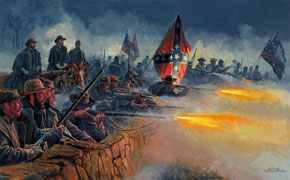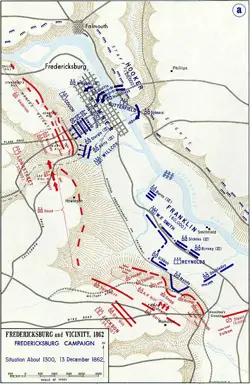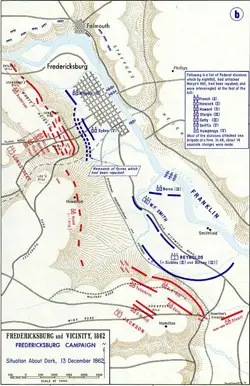Civil War Battles |
Colonial Wars |
American Wars |
Link To This Page — Contact Us —
The Battle of Fredericksburg (First)
December 13, 1862 in Fredericksburg, Virginia
 |
|||||||||||||||||||||
|
Books on The Battle of Fredericksburg (First) & the Fredericksburg Campaign
are available from Amazon.com
Maj. Gen. Ambrose E. Burnside, in response to requests and proddings from President Abraham Lincoln and General-in-Chief Maj. Gen. Henry W. Halleck, planned a late fall offensive in which he hoped to cross the Rappahannock River, seize the city of Fredericksburg, and then move southward along the roads to Richmond. This plan was spoiled due to issues with the delivery of the pontoon bridges, even though crossable fords had been located both upstream and downstream. During the delay, the Confederates rushed forces to Fredericksburg to oppose the crossing. By the time the pontoons were laid, Lee was dug in south and west of Fredericksburg.
Burnside went ahead with the crossing and elected to fight Gen. Robert E. Lee, despite objections from at least two of his general staff, who believed the Confederate position was too strong. He counted his army's numerical strength to drive Lee out of his defensive positions and force him to retreat toward Richmond. In addition to his troop's numerical advantage, Burnside also had the advantage of knowing his army could not be attacked effectively. On the other side of the Rappahannock River, 300 artillery pieces had been located on a ridge known as Stafford Heights to prevent Lee's army from mounting any major counterattacks.
 Situation about 1300 Click Map To Enlarge |
Lee had great faith in his army, even though he was fairly uncertain of the plans of the opposing commander as late as 2 days before the Union army attempted a crossing. He deployed 20,000 men on his left flank, which was anchored on the ridge known as Marye's Heights, just to the west of the city, behind a stone wall at the crest of the ridge. Fearing a crossing downstream, south of the city, he deployed the rest of his men to the south, also interspersed with hills which made for an excellent defensive position. He assigned Lt. Gen. James Longstreet, his best subordinate for defensive operations, to handle the left flank with his I Corps. On the right, where there was some chance of counterattacking if the opportunity presented itself, Lee posted Lt. Gen. Thomas J. "Stonewall" Jackson and his smaller II Corps, elements of which had performed with great valor in recent actions in the Shenandoah Valley Campaign.
On December 11, with the bridges in place, the Union forces crossed the Rappahannock in the face of Confederate sharpshooters who had taken up positions inside abandoned buildings within the city and were picking off engineers in the morning fog. Attempting to drive the sharpshooters out, Union artillery bombardments destroyed many of the buildings without much effect. The workable solution was to send small teams of infantry across in boats. After the 5 bridges were in place, Burnside's men looted the city with a fury that enraged Lee, who compared their depredations with those of the ancient Vandals. The destruction also angered Lee's men, many of whom were native Virginians. Over the course of that day and the next, Burnside's men deployed outside the city and prepared to attack Lee's army.
On December 13, Burnside began to move his men into position. Burnside planned to launch two simultaneous attacks. One was up Marye's Heights, where Longstreet's men were backed by Confederate artillery guns, and had a stonewall in front of them. The result was devastating for the attackers. More than 10,000 Union soldiers were injured trying to climb the hill and penetrate the Confederate wall. Not one Union man made it within 100 yards of the wall.
 Situation after Dark Click Map To Enlarge |
To the south, Maj. Gen. William B. Franklin sent 2 divisions into a previously unseen gap in Jackson's defenses on the right. Jackson quickly responded with a withering counterattack that inflicted heavy casualties on the attackers, and dissuaded Burnside from any more attacks on the Confederate right. Instead, he decided to attempt to break the left.
The attack seemed to be going well, until Franklin forgot to send any reinforcements and a counterattack drove Meade out with ease. Meade's division, on the Union left flank, briefly penetrated Jackson's line but was driven back by a counterattack.
Burnside had ordered division after division of his army to assault Marye's Heights. Each division was mowed down by Longstreet's defenders as it attempted to cross the open ground in front of Marye's Heights. Seven Union divisions were sent in, generally one brigade at a time, for a total of 14 individual charges, all of which failed, costing the divisions over 9,000 casualties. The falling of darkness and the entreaties of Burnside's subordinates were enough to put an end to the attacks. Thousands of Union soldiers spent the night on the fields leading to Marye's Heights, unable to move or assist the wounded due to Confederate fire.
On December 14, the armies remained in position throughout the day, when Burnside briefly considered leading his old IX Corps in one final attack on Marye's Heights, but reconsidered. That afternoon, he asked Lee for a truce to attend to his wounded, which Lee graciously granted.
On December 15, Burnside called off the offensive ordered his beaten army back across the Rappahannock, ending the campaign. Darkness put an end to the useless slaughter. The Union had lost almost 13,000 soldiers in a battle in which the dreadful carnage was matched only by its futility. Union morale plummeted, and Burnside was swiftly relieved of his command. By contrast, the morale of the Confederacy reached a peak. The battle became a Union slaughterhouse. Their casualties had been considerably lighter than the Union's, totaling only 5,000. Lee's substantial victory at Fredericksburg, won with relative ease, increased the already buoyant confidence of the Army of Northern Virginia, which led subsequently to the invasion of the North the following summer.
The Battle of Fredericksburg was remembered as one of the most one-sided battles of the Civil War.
The casualties sustained by each army showed clearly how disastrous the Union army's tactics were, and Burnside was relieved of command a month later, following the humiliating failure of his "Mud March".
